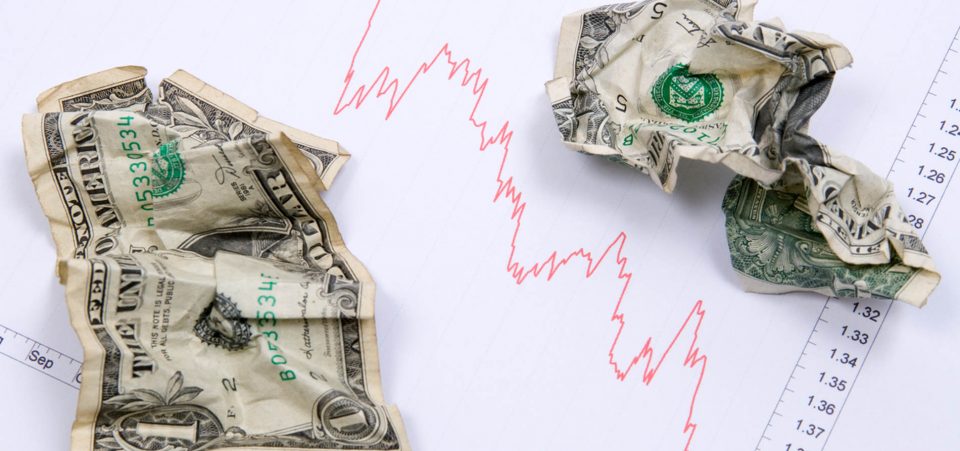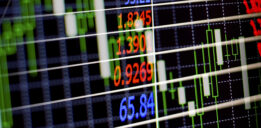A U.S. Stock Market Correction 2017 Could Be Inevitable
The Dow Jones has closed on a high for 12 days in a row recently. That’s the best bullish record streak of the past three decades. There was a 13-day winning streak in January 1987. We all know what happened later that year: the third worst crash in Wall Street history. That wasn’t a correction as much as a crash. But the next stock market correction could be far worse.
There’s no doubting the fact that Wall Street remains the brightest star of the international markets, setting the umpteenth high. But what does the future hold? The concept that what goes up must come down is not just valid in physics. Sooner or later, the next stock market correction will happen and it will look like a major crash.
It might be premature to suggest a major correction now. The markets are flying because the immigration ban, military spending, and protectionism have shown that Trump intends to keep his electoral promises. Thus, there might still be room for more records. But, at the first sign that Trump’s policies aren’t working, expect a major market correction, if not a downright crash.
What Is a Market Correction?
A market correction in the financial market occurs when stock prices pull back. It can be regional, but increasingly, the effects and causes are global. Typically, a correction announces its ominous arrival through a sudden short-term drop in market prices that could be attributed to extraneous circumstances unrelated to the underlying financial conditions of a stock.
Stocks can lose up to 10% of their value in a correction, although bigger corrections—that is, bigger losses—are not rare. The loss or a correction as opposed to a crash occurs over a longer period, giving investors the chance to get out or take some corrective actions.
Thus, market corrections still leave room for strategies that might work if the investor is in a financial position to make changes. In a crash, there is no such possibility. The course of the markets now suggest that the next correction could thump like a crash.
Trump plans to ask Congress to increase military spending by over $50.0 billion. He plans to divert money budgeted for the State Department and other agencies to achieve it. Yet he also expects to lower taxes for most Americans and for businesses. That’s a tall order to achieve.
Even Republicans fear a sharp rise in the budget deficit. Because of Donald Trump policies, meanwhile, Saudi Arabia wants to push oil prices back up to $60.00/barrel. Surely, President Trump, who would appreciate the effect it will have on stimulating American shale oil production, would welcome such a development. But the markets will like it less.
A sudden rise in oil prices would trigger inflation-raising mechanisms in the United States. Wall Street will not like this. The Federal Reserve will raise interest rates and sustain a higher dollar in the anti-free trade and mercantilist climate that Trump is promoting. Moreover, the European Union (EU) might be forced to cut short its quantitative easing program.
Beware Triggers for a U.S Market Correction 2017 from Europe
The EU is trying to raise inflation. But it wants to achieve this through a higher GDP growth rate in key economies that have stagnated lately. The European Central Bank (ECB) has purposely kept the cost of borrowing as close to zero as possible to stimulate growth. Instead, inflation from higher energy costs could trigger a recession.
Consider that Trump himself must be expecting a U.S. stock market correction 2017. During the election campaign, Trump described the current market as a big bubble. In the mean time, the market bubble keeps inflating, raising the prospects of a stock correction. Yet Trump is the main reason the markets keep climbing.
The problem is that many traders are hopeful that Trump will announce phenomenal fiscal changes over the next few weeks. Admittedly, there have also been good macro signals from the U.S. economy. The manufacturing sector, which appeared to be slumping along after years of apparent neglect, has attracted interest.
Trump’s main economic growth plan revolves around the idea to bring back manufacturing jobs to the United States. This optimism could last well until the end of March, if not even a little longer, coinciding with the market’s honeymoon period with the new administration. After that, the season of market reversal could be upon us.
Stock Market Forecast for the Next Three Months
It might start with a series of relatively small corrections. Perhaps a disappointing statistic after the announcement of Trump’s fiscal plan. After all, there is never a shortage of critics even when they get what they have demanded. As an interesting sideline, after berating Trump for his alleged Russia ties, Senator John McCain was complaining that the White House’s increased military spending proposals were insufficient.
But the list of market correction triggers won’t stop after that. March is just when things will start to get interesting. For starters, the markets will be watching the Fed closely. The next Federal Reserve interest rate decision could provide the real catalyst for a more pronounced correction.
If Janet Yellen approves a hike, which the markets deem excessive, it could slow growth. Few know what impact the next interest rate hike, or series of hikes, might have after a period of almost a decade at near zero. If Yellen moves too quickly, the more inward-looking U.S. economy could enter a deep recession, let alone a market correction.
But, more protectionist or not, the U.S. is still part of the world system of nation states. Finance knows few barriers and the international markets are interconnected. Even Trump’s “America First” philosophy will not manage to protect Wall Street from the impact and tensions of the next season of European elections.
These political events, evidently, trigger either corrections or hikes, depending on expectations. In 2017, expectations are that nationalist anti-euro parties will win big in Europe.
The first election takes place in Holland on March 15. If Geert Wilders of the Party for Freedom (PVV) should win, he might not form a government. In Holland’s proportional electoral system, the PVV would play the kingmaker role. Any prime minister that emerges will have to pay close attention to the PVV’s anti-euro stance.
In April, France will vote. Marine Le Pen, an ardent anti-euro politician, has a great chance of becoming president. She is gathering momentum with traditionally leftist voters like farmers.
There might be an Italian election along similar lines to the Dutch and French elections. And then there’s the German election. All of this will happen in 2017, and each election carries the risk of a massive economic correction. But, should one more EU member country vote to leave—or elect a political party promising to lead the way out of Europe—the markets will not sustain the current bullish pace.
Each of the next European elections could serve as the needle that bursts the bubble on Wall Street. Trump might want to make America less dependent on the external economy, but the reality is that the United States is deeply intertwined with the rest of the world at present. What happens in Amsterdam or Paris can still trigger a domino effect directly to Wall Street.
The markets are certainly buoyant now, but the general international climate is wrought with tension. The world is experiencing a high-risk stage. It might be best to step back and wait for a market correction, given the possibility, if not the probability, of a U.S. stock market correction 2017.
Apart from the forthcoming political pitfalls, “Trumponomics,” and the EU election season at hand, there are underlying economic triggers for the next correction. Wall Street has been climbing since the end of 2009. The climb began as a reaction to the bi-partisan Wall Street bailout, marking the start of the Barack Obama administration.
Market Correction or Stock Market Crash 2017?
But, if you see the chart above, the Dow Jones index has been on a virtual vertical climb since that time. A chart like that is an automatic warning that something must be rather optimistic about price-to-earnings ratios. The price-to-earnings ratio of the S&P 500 is 17.6; that’s a lofty level reached maybe two or three times in the history of U.S. stocks.
The last time was in 2014. That’s cause for alarm. That price-to-earnings (P/E) value should trigger the stock market crash 2017. The levels are simply alarming. (Source: “Valuations Soar As Markets Rally: S&P’s Highest Forward P/E Ratio Since 2004,” Benzinga, February 21, 2017.)
That eerie sensation that you, as an investor, are feeling despite the fact the DJIA is hitting new heights has a reason; it’s an instinct that tells you that the markets have already gone beyond any reasonable expectation of economic expansion. And that’s if Trumponomics succeeds. Therefore, you should expect a slowdown.
Perhaps you may even consider the possibility that a disaster lurks after the next market correction. Remember that in 2000, after the tech bubble was punctured, the correction saw some stocks drop by 40%. The problem with corrections and crashes is that investors who have horses in the race are always the last to see the crashes coming.
They are too busy monitoring the performance of their stocks or portfolios from the trenches. They do not see the whole battle, let alone the war, like those on the outside looking in. At the same time, nobody is scared when the markets are as buoyant as they are now. Yet there is always the possibility of a correction. What changes are the chances and the conditions for a correction.
Considering the sum of political and economic risks, there is a high probability of a market correction. The question is when, but the hints of the timing have not been shy, hiding away. They are rather evident for those who choose to look for warning signs. As much trust as you might have in Trump’s ability to improve the economy, consider that he has less room to act than many thought.
The public debt ratio to GDP is 105%. Can Trump raise the debt above this threshold? Not really. He can’t afford to play with the debt, yet he must fund the promised infrastructure projects from somewhere, and higher taxes aren’t on the agenda.
The prospects for a sustained rally of the financial markets are slim in 2017. The uncertainties over the euro, the eurozone, Trump’s disruption of the entire system, and his voters’ expectations have raised the stakes.
Amid these political risks and intermittent concerns about the health of the global financial system—namely European banks—should cause significant volatility. Therefore, the next stock market correction could trigger a major recession.







